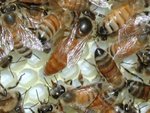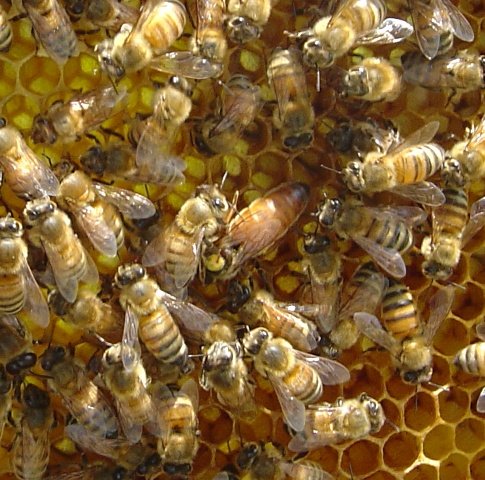
A Queen mating box under construction. You can see the three removable divider making four seporate compartments. Click on the picture for a larger image.
The damp weekend gave me time to work on my queen mating boxes. These are standard deep hive bodies (boxes) which have been divided into four, Two frame sections. This mating box will sit on a special bottom board giving each section its own separate entrance.
.
(left) Looking down inside a compartment to the screened bottom below.
.
.
.
.
.
..
(Below) The special screened bottom board. See how each section will have it's own entrance?
.
The plan is, that once queen cells have been raise to the point where the queen is ready to
emerge, each one of these sections will receive a queen cell, with two full frames
of bees and capped brood. Once the queen emerges from her cell she will take two to three mating flights where she will mate with multiple males, 12 to 15. Upon completing her mating process she will return to her compartment and start to lay fertilized eggs. She can then be evaluated, marked, and introduce into a colony who’s queen is failing.
emerge, each one of these sections will receive a queen cell, with two full frames
of bees and capped brood. Once the queen emerges from her cell she will take two to three mating flights where she will mate with multiple males, 12 to 15. Upon completing her mating process she will return to her compartment and start to lay fertilized eggs. She can then be evaluated, marked, and introduce into a colony who’s queen is failing.
The forsythia has begun to bloom, as well as the peach trees, and early dandelions.
Forsythia Blossom
.
The forsythia is an important pollen producer for the honey bee in spring. The bees will collect the abundant pollen to use as food for the young.
The peach tree in our yard is always the first fruit tree to bloom. It’s pink flowers are pretty contrast against the yellow flowering forsythia.
Peach Blossom
The blooming of the dandelions are a traditional signal to the northern beekeeper to switch the  two deep hive bodies. During the winter months the cluster of bees will work its way around the stores of honey in the hive. They group themselves together into a tight ball, and by moving there wing muscles without moving their wings, they generate enough heat to keep the center of the cluster at 90 degrees. This “ball” of bees will move as a group around the hive and slowly consume the 50 pounds or so of honey that has been stored in the combs. By spring they are almost always in the upper of the two boxes. This is convenient for the beekeeper, because if extra food is required, a sugar candy mixture can be added on top of the frames of bees to sustain them until they can collect food in the spring. Once the dandelions show up, it is warm enough to place the top box with most of the bees, and the queen, on the bottom, and place the mostly empty box of comb on top of the box with the queen.
two deep hive bodies. During the winter months the cluster of bees will work its way around the stores of honey in the hive. They group themselves together into a tight ball, and by moving there wing muscles without moving their wings, they generate enough heat to keep the center of the cluster at 90 degrees. This “ball” of bees will move as a group around the hive and slowly consume the 50 pounds or so of honey that has been stored in the combs. By spring they are almost always in the upper of the two boxes. This is convenient for the beekeeper, because if extra food is required, a sugar candy mixture can be added on top of the frames of bees to sustain them until they can collect food in the spring. Once the dandelions show up, it is warm enough to place the top box with most of the bees, and the queen, on the bottom, and place the mostly empty box of comb on top of the box with the queen.

 two deep hive bodies. During the winter months the cluster of bees will work its way around the stores of honey in the hive. They group themselves together into a tight ball, and by moving there wing muscles without moving their wings, they generate enough heat to keep the center of the cluster at 90 degrees. This “ball” of bees will move as a group around the hive and slowly consume the 50 pounds or so of honey that has been stored in the combs. By spring they are almost always in the upper of the two boxes. This is convenient for the beekeeper, because if extra food is required, a sugar candy mixture can be added on top of the frames of bees to sustain them until they can collect food in the spring. Once the dandelions show up, it is warm enough to place the top box with most of the bees, and the queen, on the bottom, and place the mostly empty box of comb on top of the box with the queen.
two deep hive bodies. During the winter months the cluster of bees will work its way around the stores of honey in the hive. They group themselves together into a tight ball, and by moving there wing muscles without moving their wings, they generate enough heat to keep the center of the cluster at 90 degrees. This “ball” of bees will move as a group around the hive and slowly consume the 50 pounds or so of honey that has been stored in the combs. By spring they are almost always in the upper of the two boxes. This is convenient for the beekeeper, because if extra food is required, a sugar candy mixture can be added on top of the frames of bees to sustain them until they can collect food in the spring. Once the dandelions show up, it is warm enough to place the top box with most of the bees, and the queen, on the bottom, and place the mostly empty box of comb on top of the box with the queen.
An overwinterd collony being fed sugar candy. See how all the bees are clustered in one area?
Since the queen likes to move upward in a hive, she will be able to lay eggs below, and when the lower box is depleted of space, she can move upward to the empty combs, which are now being filled with pollen and nectar from the spring flowers. This allows a more rapid buildup of bees in preparation to the main honey flow (nectar flow) which starts here on Cape Cod around the last week of May. Now is buildup time. The more bees we have, the more honey will be produce, but also the greater chance of swarming.
But more about that next time……



















